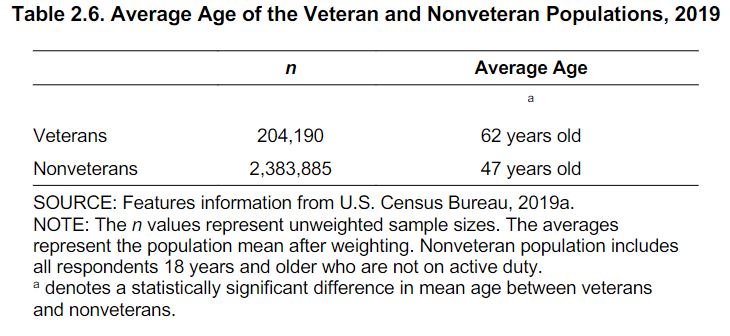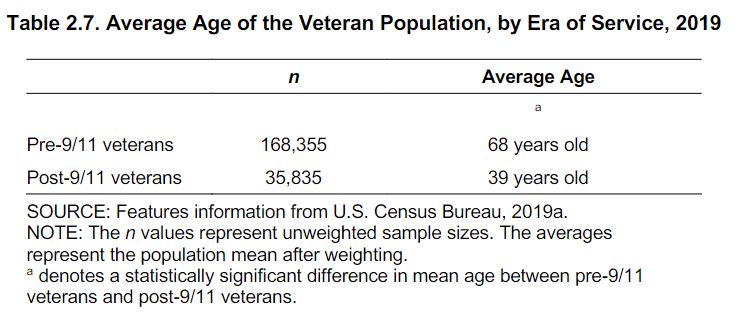SANTA MONICA, CA — U.S. military veterans are declining as a percentage of the population and are, on average, older, more likely to be male and less racially or ethnically diverse than the overall nonveteran population, reports a new factbook that sheds light on demographics, mental health and labor market outcomes.
“As a research institute, we wanted to provide a concise snapshot of the current U.S. veteran population to support the work of policymakers and researchers focused on veteran-related issues,” said Megan Schuler, PhD, MS, a policy researcher at the Rand Corp. and a member of the research team that conducted the statistical analyses that formed the bases of the factbook and led the design of infographics that accompanied the report.1
The report is organized into three sections, each focusing on different aspects of the veteran population. The first section examines demographic trends and estimates using data primarily from the American Community Survey (ACS). The ACS, initiated by the U.S. Census Bureau in 2000, provides continuous estimates of demographics during intercensal years. The second section delves into mental and behavioral health of veterans, relying on data primarily from the National Survey on Drug Use and Health (NSDUH), an annual survey covering drug use and mental health in the US population aged 12 and older. The third explores veterans’ participation in the labor market, drawing data primarily from the Current Population Survey’s (CPS) Annual Social and Economic Supplement (ASEC), a monthly survey capturing employment and demographic data for the U.S. civilian population.
Each section begins with a discussion of the publicly available data and the methodology used for analysis and then presents statistics and estimates derived from these data to describe trends in veterans’ demographics, mental and behavioral health, and labor market outcomes. Throughout the report, Rand researchers present comparisons between veterans and nonveterans are presented, and significance testing is conducted to identify meaningful differences.
While the veteran population as a whole is older and less diverse than the overall nonveteran population, post-9/11 veterans constitute a younger, more diverse group in terms of gender, race and ethnicity, with higher education levels compared to earlier veteran cohorts, according to the report. Although the absolute number of post-9/11 veterans is increasing, they still represent less than a quarter of the total veteran population.
Other findings related to work and participation in the labor market and mental and behavioral health included:
Work and participation in the labor market:
- Veterans, regardless of race/ethnicity, have lower unemployment rates than nonveterans and are more likely to work in the public sector. The top industries for veteran employment are public administration, transportation and warehousing, as well as manufacturing industries. They are underrepresented in educational services, healthcare and social assistance, as well as accommodation and food-service industries compared with nonveterans.
- There were significant variations in unemployment rates and labor force participation rates among veterans based on their race and ethnicity, differing from nonveterans.
- Working-age veterans were more heavily concentrated in mid to upperfamily-income brackets than nonveterans.
Mental health and behavioral health:
- Approximately 6.9% of veterans experienced serious psychological distress in the past year, with higher rates observed among female, gay/lesbian, bisexual, and post-9/11 veterans.
- Nearly one-quarter of all veterans report binge-drinking within the past month. Post-9/11 veterans have higher rates of all substance-use behaviors, including alcohol and drug use disorders, than pre-9/11 veterans.
- Younger veterans (under 65) were more likely to seek mental health treatment than their nonveteran counterparts, while older veterans (65 and older) were less inclined to seek such treatment. Veterans, across all age groups, were more likely to seek alcohol/drug treatment than nonveterans.
The Rand Corp. is a research organization that develops solutions to public policy challenges to help make communities throughout the world safer and more secure, healthier and more prosperous, according to the corporation’s website.
The factbook and accompanying infographics are publicly available for free on the Rand’s Veterans Policy Research Institute website, Schuler said.
Although the factbook is the first to be generated by Rand’s Veterans Policy Research Institute, she said the group intends to update it regularly as new federal data are released.
- Robinson, E., Lee, J. W., Ruder, T., Schuler, M. S., Wenig, G., Farmer, C. M., Phillips, J., & Ramchand, R. (2023). (rep.). A Summary of Veteran-Related Statistics. Santa Monica , CA: Rand Corp. https://www.rand.org/pubs/research_reports/RRA1363-5.html.


